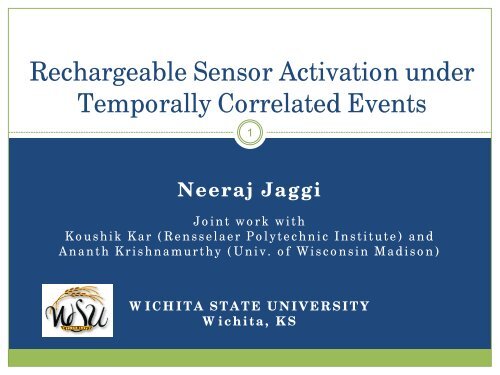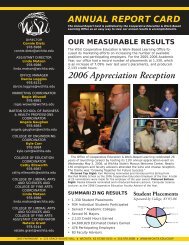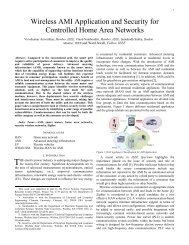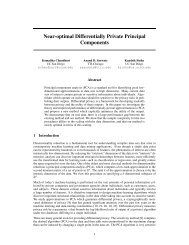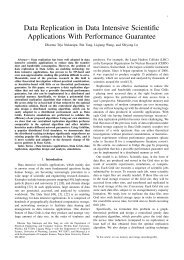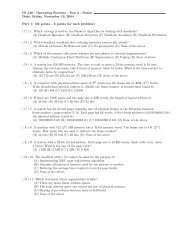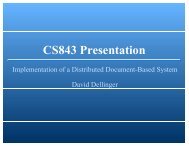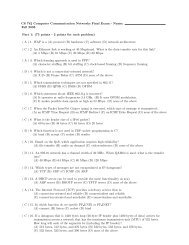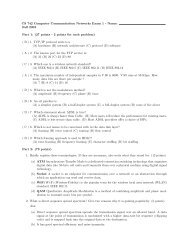Neeraj Jaggi - Witchita State University - Wichita State University
Neeraj Jaggi - Witchita State University - Wichita State University
Neeraj Jaggi - Witchita State University - Wichita State University
You also want an ePaper? Increase the reach of your titles
YUMPU automatically turns print PDFs into web optimized ePapers that Google loves.
Rechargeable Sensor Activation under<br />
Temporally Correlated Events<br />
1<br />
<strong>Neeraj</strong> <strong>Jaggi</strong><br />
Joint work with<br />
Koushik Kar (Rensselaer Polytechnic Institute) and<br />
Ananth Krishnamurthy (Univ. of Wisconsin Madison)<br />
WICHITA STATE UNIVERSITY<br />
<strong>Wichita</strong>, KS
Outline<br />
2<br />
• Sensor Networks<br />
• Rechargeable Sensor System<br />
◦ Design of energy-efficient algorithms<br />
◦ Activation question – Single sensor scenario<br />
• Temporally correlated event occurrence<br />
◦ Perfect state information<br />
Optimal policy<br />
◦ Imperfect state information<br />
Structure of optimal policy<br />
Practical algorithm with performance guarantees<br />
<strong>Neeraj</strong> <strong>Jaggi</strong> Dept of EECS <strong>Wichita</strong> <strong>State</strong> <strong>University</strong>
• Sensor Nodes<br />
◦ Tiny, low cost devices<br />
◦ Prone to Failures<br />
◦ Redundant Deployment<br />
◦ Rechargeable Sensor Nodes<br />
• Range of Applications<br />
• Important Issues<br />
◦ Energy Management<br />
◦ Quality of Coverage<br />
Sensor Networks<br />
3<br />
<strong>Neeraj</strong> <strong>Jaggi</strong> Dept of EECS <strong>Wichita</strong> <strong>State</strong> <strong>University</strong>
Rechargeable Sensor System<br />
4<br />
Event Phenomena<br />
Renewable Energy<br />
Randomness<br />
Spatio-temporal Correlations<br />
Control<br />
Rechargeable Sensors<br />
Discharge<br />
Recharge<br />
Activation Policy<br />
Quality of Coverage<br />
<strong>Neeraj</strong> <strong>Jaggi</strong> Dept of EECS <strong>Wichita</strong> <strong>State</strong> <strong>University</strong>
Dynamic Sleep Scheduling<br />
5<br />
• How should a sensor be activated (“switched on”)<br />
dynamically so that the quality of coverage is<br />
maximized over time ?<br />
• A sensor became ready. What should it do ?<br />
◦ Activate itself now :<br />
Gain some utility in the short-term<br />
◦ Activate itself later :<br />
No utility in the short term<br />
Activate when the system “needs it more”<br />
<strong>Neeraj</strong> <strong>Jaggi</strong> Dept of EECS <strong>Wichita</strong> <strong>State</strong> <strong>University</strong>
Temporal Correlations<br />
• Goal – Try to detect certain interesting events<br />
• Correlated Event Process (e.g. Forest fire)<br />
◦ On period (events occurring)<br />
Region is HOT<br />
◦ Off period (events not occurring)<br />
Region is COLD<br />
◦ Correlation probabilities<br />
on off<br />
p c<br />
p c<br />
0.5 < ( , ) < 1<br />
6<br />
( = = 0.8)<br />
• Performance Criteria – Single Sensor Node<br />
◦ Fraction of Events Detected over time<br />
on<br />
p c<br />
off<br />
p c<br />
<strong>Neeraj</strong> <strong>Jaggi</strong> Dept of EECS <strong>Wichita</strong> <strong>State</strong> <strong>University</strong>
Sensor Energy Consumption Model<br />
7<br />
• Discrete Time Energy Model<br />
◦ Operational Cost (δ 1 )<br />
◦ Detection Cost (δ 2 )<br />
◦ Recharge Rate (qc)<br />
sensor activated<br />
K<br />
δ 1 +δ 2<br />
discharge - On period<br />
• System Parameters<br />
◦ Recharge – Bernoulli<br />
c w.p. q<br />
0 otherwise<br />
qc<br />
recharge<br />
◦ Discharge – Depends upon<br />
Event occurrence (Random)<br />
discharge - Off period<br />
activation policy<br />
sensor not activated<br />
(no discharge)<br />
Activation decisions (Policy)<br />
<strong>Neeraj</strong> <strong>Jaggi</strong> Dept of EECS <strong>Wichita</strong> <strong>State</strong> <strong>University</strong><br />
δ 1
System Observability<br />
8<br />
• Perfect <strong>State</strong> Information (Completely Observable)<br />
◦ Sensor can always observe state of event process (even<br />
while inactive)<br />
• Imperfect <strong>State</strong> Information (Partially Observable)<br />
◦ Inactive sensor can not observe current state of event<br />
process<br />
<strong>Neeraj</strong> <strong>Jaggi</strong> Dept of EECS <strong>Wichita</strong> <strong>State</strong> <strong>University</strong>
Approach/Methodology<br />
9<br />
• Perfect <strong>State</strong> Information<br />
◦ Formulate Markov Decision Problem (MDP)<br />
◦ Upper Bound on Performance<br />
◦ Optimal Policy<br />
• Imperfect <strong>State</strong> Information<br />
◦ Formulate Partially Observable MDP (POMDP)<br />
◦ Transform POMDP to equivalent MDP (Known techniques)<br />
◦ Structure of Optimal Policy<br />
◦ Near-optimal practical Algorithms<br />
<strong>Neeraj</strong> <strong>Jaggi</strong> Dept of EECS <strong>Wichita</strong> <strong>State</strong> <strong>University</strong>
Perfect <strong>State</strong> Information<br />
• Markov Decision Process (Finite K)<br />
◦ <strong>State</strong> Space = {(L, E); 0 ≤ L ≤ K, E є [0, 1]}<br />
L – Current Energy Level, E – On/Off period<br />
Reward r– one if event detected; zero otherwise<br />
Action u є [0, 1]; Transition probabilities p<br />
10<br />
• Optimality equations (average reward criteria)<br />
◦ h* – state variables<br />
◦ λ* – optimal reward<br />
<strong>Neeraj</strong> <strong>Jaggi</strong> Dept of EECS <strong>Wichita</strong> <strong>State</strong> <strong>University</strong>
Perfect <strong>State</strong> Information (contd.)<br />
• Approximate Solution<br />
11<br />
◦ Closed form solution for h* does not seem to exist<br />
• Value Iteration<br />
◦ Activation Algorithm<br />
When L
Performance Bound<br />
• Upper Bound on achievable performance for any<br />
stationary policy (Infinite K)<br />
◦ Have to consider “low recharge rate” and “high recharge<br />
rate” cases separately<br />
12<br />
◦ Useful observation to derive the bounds<br />
Success probability for event detection is upper bounded by<br />
on<br />
p c<br />
OR (Event predictability is upper bounded by )<br />
on<br />
p c<br />
<strong>Neeraj</strong> <strong>Jaggi</strong> Dept of EECS <strong>Wichita</strong> <strong>State</strong> <strong>University</strong>
Optimal Activation Policy<br />
• Optimal policy structure<br />
13<br />
◦ Activate when events are occurring<br />
◦ Activate with a probability when events are not occurring<br />
P* is directly proportional to the recharge rate<br />
Attains Energy Balance<br />
Average recharge rate equals average discharge rate in steady state<br />
<strong>Neeraj</strong> <strong>Jaggi</strong> Dept of EECS <strong>Wichita</strong> <strong>State</strong> <strong>University</strong>
• Difficulty<br />
Imperfect <strong>State</strong> Information<br />
14<br />
◦ <strong>State</strong> partially observable when sensor is inactive – (L , E )<br />
• Partially Observable Markov Decision Process<br />
◦ Is converted to a completely observable MDP<br />
With a transformed state space of the form (L, E, t)<br />
◦ Information available while decision making<br />
L – Current Energy Level<br />
E – <strong>State</strong> of event process last observed (while in active state)<br />
t – Number of time slots spent in inactive state<br />
◦ Optimal policy<br />
Can now be computed numerically using value iteration<br />
Optimal actions do not seem to have a closed form expression<br />
<strong>Neeraj</strong> <strong>Jaggi</strong> Dept of EECS <strong>Wichita</strong> <strong>State</strong> <strong>University</strong>
Structure of Optimal Policy<br />
• Optimal actions computed using value iteration algorithm<br />
◦ Threshold energy wakeup functions<br />
f 0 – (L, 0, t), f 1 – (L, 1, t)<br />
15<br />
◦ Properties<br />
Last observed state ON<br />
Aggressive Wakeup<br />
Last observed state OFF<br />
Reluctant Wakeup<br />
◦ Sensitive to system parameters<br />
◦ Convergence of f 0 and f 1<br />
Effects of temporal correlations diminish over time<br />
<strong>Neeraj</strong> <strong>Jaggi</strong> Dept of EECS <strong>Wichita</strong> <strong>State</strong> <strong>University</strong>
Near-Optimal Policies<br />
• AW (Aggressive Wakeup) Policy<br />
◦ Activate whenever sufficient energy available L ≥ δ 2 + δ 1<br />
◦ Ignores temporal correlations<br />
16<br />
◦ Optimal if no temporal correlations<br />
• CW (Correlation dependent Wakeup) Policies<br />
◦ Activate during On periods; Deactivate during Off<br />
◦ Employ an appropriate sleep duration<br />
Performance depends upon sleep duration<br />
◦ Upper Bound U * CW =<br />
◦ Best CW policy performance<br />
ε-optimal (ε ~ O(1/β)); β = δ 2 /δ 1<br />
<strong>Neeraj</strong> <strong>Jaggi</strong> Dept of EECS <strong>Wichita</strong> <strong>State</strong> <strong>University</strong>
EB-CW Policy<br />
• Energy balancing CW policy<br />
◦ Sleep Interval (SI*)<br />
17<br />
Derived using energy balance during a renewal interval [t 1 t 2 ]<br />
A A A A A A<br />
Y Y Y Y Y N<br />
I<br />
SI<br />
I<br />
A A A A<br />
Y Y Y N<br />
I<br />
A – Active<br />
I – Inactive<br />
Y – On, N – Off<br />
SI – sleep duration<br />
t 1 , t 2 – renewal<br />
instances<br />
• Coupled equations<br />
◦ Fixed point exists<br />
t 1<br />
t 2<br />
t<br />
<strong>Neeraj</strong> <strong>Jaggi</strong> Dept of EECS <strong>Wichita</strong> <strong>State</strong> <strong>University</strong>
Simulation Results<br />
18<br />
[δ 1 = c = 1, δ 1 = 6, q = 0.5, K = 2400]<br />
on off<br />
[ = 0.6, = 0.9, SI * on off<br />
p = 7] [ = 0.7, = 0.8, SI * c<br />
pc<br />
= 18]<br />
Energy balancing Sleep Interval SI*<br />
<strong>Neeraj</strong> <strong>Jaggi</strong> Dept of EECS <strong>Wichita</strong> <strong>State</strong> <strong>University</strong><br />
p c<br />
p c
Summary and Contributions<br />
• We considered sensor node activation scheduling problem<br />
in a stochastic optimization framework<br />
• Finding optimal policy is difficult and closed form<br />
expressions may not exist<br />
19<br />
• Policies based upon the notion of energy balance perform –<br />
◦ Optimally for Perfect <strong>State</strong> Information<br />
◦ Near-optimally for Imperfect <strong>State</strong> Information<br />
5 th International Symposium on Modeling and Optimization in Mobile<br />
Ad hoc and Wireless Networks (WIOPT) April 2007<br />
ACM/KLUWER Wireless Networks 2008 (Accepted )<br />
<strong>Neeraj</strong> <strong>Jaggi</strong> Dept of EECS <strong>Wichita</strong> <strong>State</strong> <strong>University</strong>
Open Questions<br />
20<br />
• EB CW Policy performance<br />
◦ Is it optimal over all stationary policies ?<br />
◦ Simulation results in test cases seem to suggest so.<br />
• Extensibility to general network scenario<br />
◦ Presence of multiple sensors<br />
<strong>Neeraj</strong> <strong>Jaggi</strong> Dept of EECS <strong>Wichita</strong> <strong>State</strong> <strong>University</strong>
Q & A<br />
21<br />
THANK YOU !! <br />
<strong>Neeraj</strong> <strong>Jaggi</strong> Dept of EECS <strong>Wichita</strong> <strong>State</strong> <strong>University</strong>


